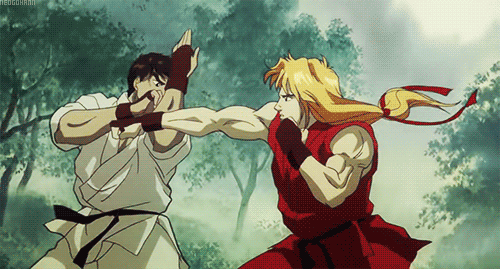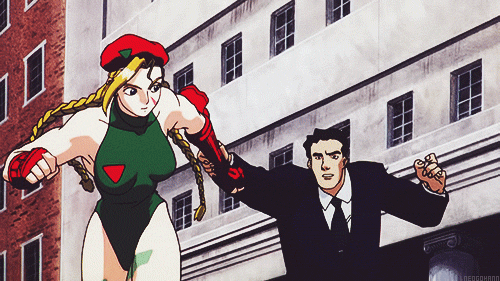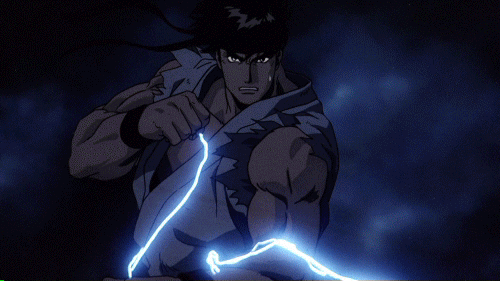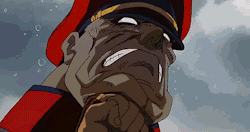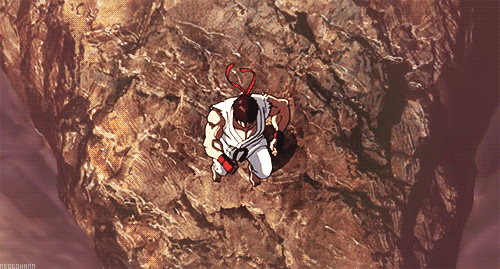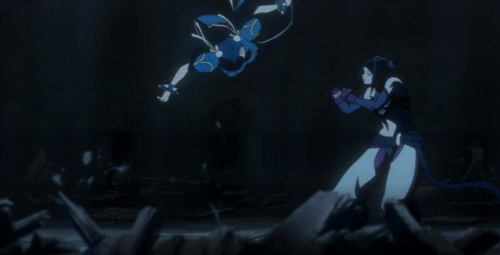With Street Fighter II: The Animated Movie recently getting a fantastic Blu-Ray re-release here in the states, I felt there was no better time to give this amazing adaptation a proper thread and an introspective look-back at what I easily consider to be the most amazing video game adaptation ever.
There's a lot to cover, so let's get this party started.
Street Fighter II: The Animated Movie was directed by Gisaburō Sugii way back in the golden years of 1994, just over three years after SFII first hit the scene, and eventually localized two years later for western release.
What immediately separates this adaption from so many other animated video game adaptations, such as Tekken or Samurai Shodown or Battle Arena Toshinden (remember Battle Arena Toshinden, folks?), was this film's still-stunning production values. Backgrounds are intricately detailed, character designs are impressively realistic and detailed, and the animation remains incredibly fluid, rivaling and surpassing many animated features released even today.
What also separates it out from so many other anime fighting game adaptations, which so frequently rely on an excessive amount of flashy and spectacular special attacks that tend to turn into Dragon Ball Z match-ups of fireballs and energy beams, is the film's shocking restraint, opting to instead give the fights a far more grounded and realistic approach. Actual martial artists, including K-1 founder Kazuyoshi Ishii and the late Andy Hug, helped consult and choreograph, making the fights far more dynamic and grounded. While special attacks did exist, they were kept to a minimum and even altered to have one foot planted in reality. A good example of this is Chun-Li's Spinning Bird Kick or Ryu's Hurricane Kick gaining momentum by pushing off from the ground instead of just defying gravity, even if it's still impossible to pull off in real life.
The majority of fights are hand-to-hand instead of relying on some super-move, and the filmmakers obviously took great pains to pair up opponents whose fighting styles complimented each other. Fighters lacking projectiles often squared off in the film, while those that had them only employed them as a last resort. It's one area of the film that I'm happy to see divert from the source material...
To this day, the fights in this film are some of the best ever committed to screen, animated or otherwise. A good case can be made for any of them, really, as every character gets some choice moments to shine. Fei Long vs Ryu, Ryu and Ken vs Bison, Ryu vs Sagat. For me? It's no question it's Chun-Li vs Vega. As has been talked about extensively before.
Now, some criticism COULD be levied at the film that the plot is extremely bare-bones and basic... and I'd attest that those critics are wrong. In actuality, one of the things I consider a strength to the film is its adherence to moving the action along at a brisk and steady pace, knowing full well that the audience isn't here for a touching, introspective look at the human condition or the burgeon romance between star-crossed lovers. We're here to see our favorite characters from the video game beat the living tar out of each other, and the film makes good on that promise literally in the opening seconds of the film with two fighters fighting by the street (ha! I get it now...). From there, the plot is nothing more than a glorified game of cat-and-mouse as we jump from scene to scene of Ryu wandering the globe and taking in fights while Bison's troops kill people and Chun-Li, Guile, and Interpol chase after them both.
This structure may be light on twists and character growth, but it's heavy on giving its 16(!) characters plenty of room to show off what makes them iconic and memorable. It's a feat that almost no video game adaptation can match, really. The inclusion of every character from the game, AND they all get at least one cool-as-hell moment. While obviously some get the short end of the stick (T.Hawk and Dee Jay probably feel the most shoe-horned in), I've seen dozens of other adaptations that can't say they included the whole cast of characters, or if they did to do so as well or to give them SOMETHING to do. Everyone in this film gets to punch, kick, or grapple their way to some sort of memorable moment.
"The world is now your arena, not the streets!"
Part of what makes the film seem so "big" is just how global the stage of the conflict is and how diverse the locations and backdrops of the fights are. Just like the game, the film jumps around like crazy to countless countries, and the film is meticulous in detailing and showing these places off.
From the flashy and seedy fight clubs of a Las Vegas resort to the dusty roads of India to the mountains of Thailand, the film's slowest moments are when it takes a few moments to let the atmosphere and locations drip off the screen and take you into worlds and cultures foreign to the audience. The attention to detail is spectacular, from my observation and limited global travels, with accurate touches such as temple designs to popular transportation to architecture to background street signs written in the proper language to tons of other cultural details I'm still picking up on after all these years. If Street Fighter was "the world's warriors", the film does the world justice.
"Save your strength, boy. You'll need all you can muster on the battlefield."
One thing the film does better than most adaptations as well is a sense of pacing, tone, and tension. It would have been so easy to just jump right into the fights, and to some extend they do this, but the more memorable ones to me are the ones that slowly build towards the encounters. So as cool as it is to see Ryu and Fei Long throw down...
And no fight in the film handles that pacing and sense of tension better than the Chun-li vs Vega fight.
As memorable as that shower scene was, it was the atmosphere and build up that made the payoff so sweet. I've written extensively on it before, but it's still absolutely worth a mention.
"No! We're not done yet! You haven't seen anything! Get ready!"
Though on the topic of the shower scene, Street Fighter II's adaption is pretty unique in just how much mature content it got away with. Street Fighter was right on the cusp of being a genuinely mainstream success. It was a year away from a primetime Kid's cartoon and a big Hollywood movie. While it was popular, it wasn't SO big yet that the filmmakers were too concerned about neutering or sanitizing the content for a wider audience... giving us a film with nudity, language, and violence Street Fighter will probably never see again.
As a young kid who grew up on Toonami Dragon Ball Z, seeing this level of violence was eye-opening. It's certainly not the goriest anime by any stretch, but it was Street Fighter, of which the cartoon alternative was a goofy, campy Guile-led series of misadventures with some morality theme per episode. Here, men get shot to pieces, Chun-li gets shredded by Vega's claws, and Ryu caves a man's skull in with a headbutt. Certain versions insert F-bombs, people get brutally assassinated, and Chun-li's oh-so-infamous shower scene ushered more than a few adolescent boys into manhood upon their first viewing.
While the film was hugely influential on the game series in numerous ways - from redesigns to staging to plot points - the series' increased popularity has made Capcom balk at ever dipping their toe into such a mature and adult anime interpretation since. That's disappointing, as I know they would consider it a bad business move, but for this perfect lining up of planets, we got a film adaption that - to my eternal shock and amazement - is more bloody, violent, and mature than the movie adaptation of Mortal friggin' Kombat.
"Japanese fighters stick together... 'Cause we're BROTHERS! HA HA HA!"
There feels like dozens of different versions of the film (and thankfully the new Blu-Ray release has them all!), but I'm going to assume the vast majority of viewers who first saw it growing up or who were exposed to it viewed the English dub with the redone westernized soundtrack, which was composed by Cory Lerios and John D'Andrea (of Baywatch fame), with licensed music from bands like KMFDM, Alice in Chains, and KORN. Now, as much as I respect and even like the Japanese version, there's always going to be something of a soft spot in my heart for watching Chun-li and Vega fight to the death to KMFDM's "Ultra".
The dub is the same way, somehow being both better than most dubs while being also indescribably cheesy yet memorable. It's sillier than many current dubs and has some bizarre inflections and direction, but it's also much better and more natural-sounding than the vast majority of early 90s dubs from the era. In a way, the dub has its own unique charms, and I think the only surprising miss from the cast is the otherwise legendary Steve Blum as T.Hawk, who hadn't yet perfected the growl he'd use for Wolverine or Grunt years later. The Japanese cast is consistent throughout, and, despite my preference for the English soundtrack, the Japanese score is well-done and has some real good tunes to offer as well.
The legacy of the Street Fighter II: Animated Movie lingers on strongly. Even as the game series has had its ups and downs, even as the trends of anime and adaptations have shift over the years and decades, the SFII movie remains indisputably just as watchable and entertaining as its first release. Its animation remains gorgeous and lush, its fight scenes kinetic and energetic, and its sense of pacing, style, and production values virtually unsurpassed as an adaptation. It's both amazing and sad that no other Street Fighter adaptation - or almost any video game adaptation - has come close to capturing the spirit of the games so well while remaining so delightfully entertaining.
Its influence is felt strongly still in the games themselves, in how many studios were crawling over themselves to replicate its success to diminishing returns, in how - 22 years later - old fans still relish rewatching the film and new viewers fall in love with it years after release.
It's always disheartening to revisit a film from my childhood and past and discover it hasn't held up, to be bogged down by childish humor or dated references or general poor design or ambition... but this isn't the case here. The film continues to ooze quality, care, and creativity, often exceeding its source material while simultaneously being incredibly faithful to it as well.
Over two decades later, and despite some notable competition here and there, I still don't believe it has been topped.
If you've read this far and haven't seen the film in awhile, or haven't seen it yet period, then you owe it to yourself to grab the absolutely phenomenal re-release by Discotek.
Store Link Here
Despite owning countless incarnations of the film on VHS and DVD, this is easily the definitive version and the first ACTUAL "Uncut" release of the film with an English dub in the west, finally including all the excised or condensed scenes missing from every prior international release of the film. Really, this release is one of the most impressive Blu-Ray release I've ever seen, with remastered visuals, remastered audio, and the ability to basically select any version of the film to ever have existed. This includes the ability to listen to an English dub alongside the Japanese soundtrack, for instance.
It already would have been the definitive edition of the film if they had stopped there, but throw in comprehensive production notes, the PG-13 version for posterity, narrated history of the production of the film and restoration of the Blu-Ray features, hundreds of high-quality production artwork and galleries, a breakdown of all the version differences, alternate footage, trailers, and even rare Japanese footage from the obscure video-game tie-in, and you have FAR more info and easter eggs to look over than even my post has come close to matching.
I still believe this to be a film worth celebrating, as an anime fan, as a martial arts movie fan, as a video game fan, and as a Street Fighter fan, and I'm more than happy to know my experiences and feelings are shared among a large group of viewers, including the fantastic folks at Discotek who went above and beyond to give us the best version of the film yet.
Whatever may come for the franchise, and whatever its future endeavors, the highs and the lows, it's good to know this piece of history and this part of its legacy still receives the care, attention, and acclaim it deserves.
There's a lot to cover, so let's get this party started.
"Just a Japanese guy taking in a fight. And Ryu is my name."
Street Fighter II: The Animated Movie was directed by Gisaburō Sugii way back in the golden years of 1994, just over three years after SFII first hit the scene, and eventually localized two years later for western release.
What immediately separates this adaption from so many other animated video game adaptations, such as Tekken or Samurai Shodown or Battle Arena Toshinden (remember Battle Arena Toshinden, folks?), was this film's still-stunning production values. Backgrounds are intricately detailed, character designs are impressively realistic and detailed, and the animation remains incredibly fluid, rivaling and surpassing many animated features released even today.
What also separates it out from so many other anime fighting game adaptations, which so frequently rely on an excessive amount of flashy and spectacular special attacks that tend to turn into Dragon Ball Z match-ups of fireballs and energy beams, is the film's shocking restraint, opting to instead give the fights a far more grounded and realistic approach. Actual martial artists, including K-1 founder Kazuyoshi Ishii and the late Andy Hug, helped consult and choreograph, making the fights far more dynamic and grounded. While special attacks did exist, they were kept to a minimum and even altered to have one foot planted in reality. A good example of this is Chun-Li's Spinning Bird Kick or Ryu's Hurricane Kick gaining momentum by pushing off from the ground instead of just defying gravity, even if it's still impossible to pull off in real life.
The majority of fights are hand-to-hand instead of relying on some super-move, and the filmmakers obviously took great pains to pair up opponents whose fighting styles complimented each other. Fighters lacking projectiles often squared off in the film, while those that had them only employed them as a last resort. It's one area of the film that I'm happy to see divert from the source material...
To this day, the fights in this film are some of the best ever committed to screen, animated or otherwise. A good case can be made for any of them, really, as every character gets some choice moments to shine. Fei Long vs Ryu, Ryu and Ken vs Bison, Ryu vs Sagat. For me? It's no question it's Chun-Li vs Vega. As has been talked about extensively before.
"Any man strong enough to beat the crap out of Sagat is a man I want found!"
Now, some criticism COULD be levied at the film that the plot is extremely bare-bones and basic... and I'd attest that those critics are wrong. In actuality, one of the things I consider a strength to the film is its adherence to moving the action along at a brisk and steady pace, knowing full well that the audience isn't here for a touching, introspective look at the human condition or the burgeon romance between star-crossed lovers. We're here to see our favorite characters from the video game beat the living tar out of each other, and the film makes good on that promise literally in the opening seconds of the film with two fighters fighting by the street (ha! I get it now...). From there, the plot is nothing more than a glorified game of cat-and-mouse as we jump from scene to scene of Ryu wandering the globe and taking in fights while Bison's troops kill people and Chun-Li, Guile, and Interpol chase after them both.
This structure may be light on twists and character growth, but it's heavy on giving its 16(!) characters plenty of room to show off what makes them iconic and memorable. It's a feat that almost no video game adaptation can match, really. The inclusion of every character from the game, AND they all get at least one cool-as-hell moment. While obviously some get the short end of the stick (T.Hawk and Dee Jay probably feel the most shoe-horned in), I've seen dozens of other adaptations that can't say they included the whole cast of characters, or if they did to do so as well or to give them SOMETHING to do. Everyone in this film gets to punch, kick, or grapple their way to some sort of memorable moment.

(I especially liked the part where Akuma tried to sell those people mangos. Classic Akuma!)
"The world is now your arena, not the streets!"
Part of what makes the film seem so "big" is just how global the stage of the conflict is and how diverse the locations and backdrops of the fights are. Just like the game, the film jumps around like crazy to countless countries, and the film is meticulous in detailing and showing these places off.
From the flashy and seedy fight clubs of a Las Vegas resort to the dusty roads of India to the mountains of Thailand, the film's slowest moments are when it takes a few moments to let the atmosphere and locations drip off the screen and take you into worlds and cultures foreign to the audience. The attention to detail is spectacular, from my observation and limited global travels, with accurate touches such as temple designs to popular transportation to architecture to background street signs written in the proper language to tons of other cultural details I'm still picking up on after all these years. If Street Fighter was "the world's warriors", the film does the world justice.
"Save your strength, boy. You'll need all you can muster on the battlefield."
One thing the film does better than most adaptations as well is a sense of pacing, tone, and tension. It would have been so easy to just jump right into the fights, and to some extend they do this, but the more memorable ones to me are the ones that slowly build towards the encounters. So as cool as it is to see Ryu and Fei Long throw down...
... it's helped by the deliberate pacing that first introduces us to Fei Long, gives us a quick run-down on who he is and what his motivation to fight even is, then showing him sneaking into a fight club to check out the scene, then seeing Ryu dragged into the arena against his will, then seeing Ryu wreck his opponent in one move, then that giddy feeling as he knows he's found a worthy opponent and jumps in. It builds towards the encounter, letting viewers know it's gonna happen and keeping their anticipation up until the fight actually commences.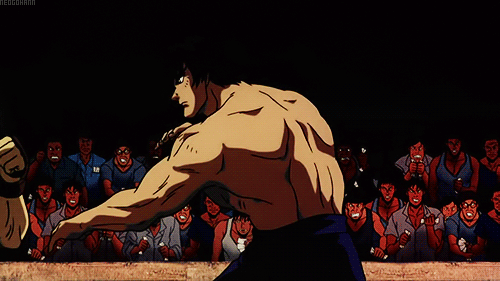
(and it is SO cool)
And no fight in the film handles that pacing and sense of tension better than the Chun-li vs Vega fight.
As memorable as that shower scene was, it was the atmosphere and build up that made the payoff so sweet. I've written extensively on it before, but it's still absolutely worth a mention.
"No! We're not done yet! You haven't seen anything! Get ready!"
Though on the topic of the shower scene, Street Fighter II's adaption is pretty unique in just how much mature content it got away with. Street Fighter was right on the cusp of being a genuinely mainstream success. It was a year away from a primetime Kid's cartoon and a big Hollywood movie. While it was popular, it wasn't SO big yet that the filmmakers were too concerned about neutering or sanitizing the content for a wider audience... giving us a film with nudity, language, and violence Street Fighter will probably never see again.

(Both of these guys are currently considered "comedy relief" in the games...)
As a young kid who grew up on Toonami Dragon Ball Z, seeing this level of violence was eye-opening. It's certainly not the goriest anime by any stretch, but it was Street Fighter, of which the cartoon alternative was a goofy, campy Guile-led series of misadventures with some morality theme per episode. Here, men get shot to pieces, Chun-li gets shredded by Vega's claws, and Ryu caves a man's skull in with a headbutt. Certain versions insert F-bombs, people get brutally assassinated, and Chun-li's oh-so-infamous shower scene ushered more than a few adolescent boys into manhood upon their first viewing.
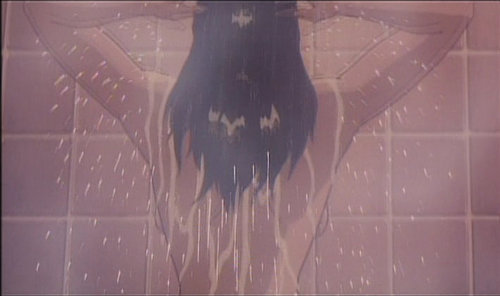
(I never looks at those hair-buns the same away again...)
While the film was hugely influential on the game series in numerous ways - from redesigns to staging to plot points - the series' increased popularity has made Capcom balk at ever dipping their toe into such a mature and adult anime interpretation since. That's disappointing, as I know they would consider it a bad business move, but for this perfect lining up of planets, we got a film adaption that - to my eternal shock and amazement - is more bloody, violent, and mature than the movie adaptation of Mortal friggin' Kombat.
"Japanese fighters stick together... 'Cause we're BROTHERS! HA HA HA!"
There feels like dozens of different versions of the film (and thankfully the new Blu-Ray release has them all!), but I'm going to assume the vast majority of viewers who first saw it growing up or who were exposed to it viewed the English dub with the redone westernized soundtrack, which was composed by Cory Lerios and John D'Andrea (of Baywatch fame), with licensed music from bands like KMFDM, Alice in Chains, and KORN. Now, as much as I respect and even like the Japanese version, there's always going to be something of a soft spot in my heart for watching Chun-li and Vega fight to the death to KMFDM's "Ultra".

(Or Bryan Cranston do his best Bruce Lee impersonation.)
The dub is the same way, somehow being both better than most dubs while being also indescribably cheesy yet memorable. It's sillier than many current dubs and has some bizarre inflections and direction, but it's also much better and more natural-sounding than the vast majority of early 90s dubs from the era. In a way, the dub has its own unique charms, and I think the only surprising miss from the cast is the otherwise legendary Steve Blum as T.Hawk, who hadn't yet perfected the growl he'd use for Wolverine or Grunt years later. The Japanese cast is consistent throughout, and, despite my preference for the English soundtrack, the Japanese score is well-done and has some real good tunes to offer as well.
"What do you see beyond your fist?"
The legacy of the Street Fighter II: Animated Movie lingers on strongly. Even as the game series has had its ups and downs, even as the trends of anime and adaptations have shift over the years and decades, the SFII movie remains indisputably just as watchable and entertaining as its first release. Its animation remains gorgeous and lush, its fight scenes kinetic and energetic, and its sense of pacing, style, and production values virtually unsurpassed as an adaptation. It's both amazing and sad that no other Street Fighter adaptation - or almost any video game adaptation - has come close to capturing the spirit of the games so well while remaining so delightfully entertaining.
Its influence is felt strongly still in the games themselves, in how many studios were crawling over themselves to replicate its success to diminishing returns, in how - 22 years later - old fans still relish rewatching the film and new viewers fall in love with it years after release.
It's always disheartening to revisit a film from my childhood and past and discover it hasn't held up, to be bogged down by childish humor or dated references or general poor design or ambition... but this isn't the case here. The film continues to ooze quality, care, and creativity, often exceeding its source material while simultaneously being incredibly faithful to it as well.
Over two decades later, and despite some notable competition here and there, I still don't believe it has been topped.
"Have you ever felt the fighting spirit of another?"
If you've read this far and haven't seen the film in awhile, or haven't seen it yet period, then you owe it to yourself to grab the absolutely phenomenal re-release by Discotek.
Store Link Here
Despite owning countless incarnations of the film on VHS and DVD, this is easily the definitive version and the first ACTUAL "Uncut" release of the film with an English dub in the west, finally including all the excised or condensed scenes missing from every prior international release of the film. Really, this release is one of the most impressive Blu-Ray release I've ever seen, with remastered visuals, remastered audio, and the ability to basically select any version of the film to ever have existed. This includes the ability to listen to an English dub alongside the Japanese soundtrack, for instance.
It already would have been the definitive edition of the film if they had stopped there, but throw in comprehensive production notes, the PG-13 version for posterity, narrated history of the production of the film and restoration of the Blu-Ray features, hundreds of high-quality production artwork and galleries, a breakdown of all the version differences, alternate footage, trailers, and even rare Japanese footage from the obscure video-game tie-in, and you have FAR more info and easter eggs to look over than even my post has come close to matching.
I still believe this to be a film worth celebrating, as an anime fan, as a martial arts movie fan, as a video game fan, and as a Street Fighter fan, and I'm more than happy to know my experiences and feelings are shared among a large group of viewers, including the fantastic folks at Discotek who went above and beyond to give us the best version of the film yet.
Whatever may come for the franchise, and whatever its future endeavors, the highs and the lows, it's good to know this piece of history and this part of its legacy still receives the care, attention, and acclaim it deserves.


